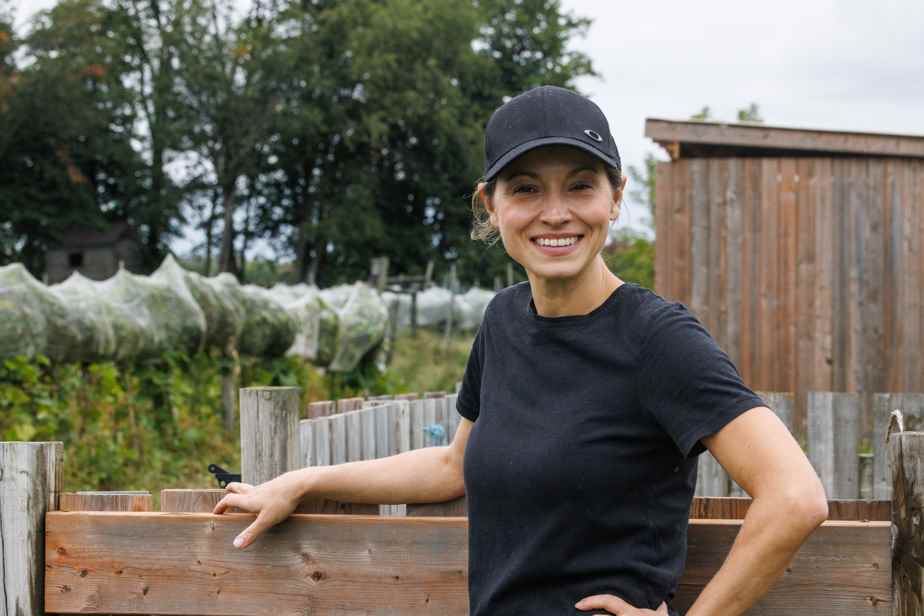Interested in the research of the “pastoral winemaker” Darek Trowbridge, “star” of this wine issue, Véronique Lemieux accompanied us to California to meet him. And although her northern reality is very different from that of the South, this researcher and new winegrower came back more motivated and convinced than ever of the urgency of taking action and practicing beneficial viticulture.
Posted yesterday at 11:00 a.m.
After working on the rooftops of Montreal for her Vignes en ville project—where, moreover, a heat worthy of Sonoma reigned in the middle of a heat wave—Véronique Lemieux felt the need to push her hands deep into the earth, or rather, in this which concerns her, in a large “heap” of RCW (fragmented ramial wood).
She had the intuition that this “homemade mulch”, drawn from the nearby forest, could be the key to a beautiful vitality. It was at the invitation of Simon Naud, owner of the 30-year-old La Bauge vineyard in Brigham, that she planted an experimental plot of aromatic La Crescent grapes in July, with her ally Steve Beauséjour.

PHOTO DENIS GERMAIN, SPECIAL COLLABORATION
Veronique Lemieux
The duo seeks to develop new methods, which Véronique likes to call “holistic Nordic viticulture”. “Holistic” as in “whole”, “global”. There’s nothing esoteric about it, although nature always has its share of mystery. It is up to humans to listen to these phenomena and to “support” their battered environment in its recovery, with patience and humility.
At the foot of the vines, therefore, Véronique and Steve have chosen to spread a layer of this famous BRF, a natural barrier that protects the integrity of the soil, which creates an environment favorable to better microbiology.
Darek Trowbridge, in his California constantly threatened by flames, swears by this method to protect his arid soils. He even founded a social enterprise, Soil Carbon Management Co, to market his Primordial Biome, consisting of overabundant “wood chips” inoculated with mycelium (mushroom filaments).
By exchanging with the pope of the BRF, by observing his vines, Véronique learned many things. There is nothing like these discussions and these visits to open up possibilities. The amount of knowledge about viticulture is enormous, overwhelming even. And that’s not counting the fact that yesterday’s methods may not work tomorrow.

PHOTO DENIS GERMAIN, SPECIAL COLLABORATION
Véronique Lemieux felt the need to sink her hands deep into a large “heap” of BRF (fragmented ramial wood).
restore harmony
What should be remembered above all is the quest of two humans for innovation with the greatest respect for our fragile environment. It is also the search for balance and solutions adapted to each situation, the restoration or the creation of harmonious natural universes, which are sufficient in themselves. What would nature do in this situation? We find this approach in the “fundamental culture” of Christian Barthomeuf (founder of Clos Saragnat) or in the “non-action” of the Japanese farmer Masanobu Fukuoka.
Of course, it is not a question of “doing nothing”, but rather of helping the environments to regain their natural balance so that they can better do without the human being afterwards. You have to work hard for several years before you can rest on your laurels. And Véronique Lemieux, a valiant woman full of energy and ideas, is not afraid to invest herself fully.

PHOTO DENIS GERMAIN, SPECIAL COLLABORATION
Steve Beauséjour, Véronique Lemieux and Simon Naud, owner of the 30-year-old La Bauge vineyard
In the spirit of a viticulture adapted to its context, Véronique Lemieux and Steve Beauséjour, sommelier and wine representative turned winemaker, have chosen to plant rustic (or hybrid) vines on their plot, which are resistant to many better cold than European vines like Chardonnay and Pinot Noir.
They left spaces in the rows to plant fruit trees and flowers, the monoculture of vines being increasingly questioned. A grape, haskap and blueberry piquette? Why not ! Hybrid drinks are popular and bear witness to this movement towards greater diversity in the vineyard. Because, in the end, the approach must also be profitable.

PHOTO DENIS GERMAIN, THE PRESS
Products from the La Bauge vineyard
Promising natural wines
At La Bauge, listening, adaptation, questioning and innovation are present even in the vinification of the fruits of all these efforts. Naturally, the experimental plot is not producing yet, but Steve Beauséjour has been supporting Simon Naud, from La Bauge, in a natural turn for a few years now. The wines, more digestible than ever, are doing very well. Les Beaux Jus cuvées, including La Renversante, DJ Meu, Le Rosé and Le Blanc (which is about to be released in Quebec grocery stores), are part of the “organic and natural” series developed by Mr. Beauséjour.

PHOTO DENIS GERMAIN, SPECIAL COLLABORATION
La Bauge’s more mature vines are covered with netting to protect them from birds ahead of the harvest, which started this week.
Véronique Lemieux has also taken up the “wine”. She had dabbled in the fermentation of grapes and other fruits through Vignes en ville and by collaborating on the La Renversante cuvée, among others. Over the past few years, she has done a host of tests. This fall, more than ever, she has both hands and both feet in it!
While waiting to be able to taste the spirits from “the” parcel, you can buy the most up-to-date trials of La Bauge in a large number of delicatessens in Quebec, directly at the vineyard or taste them in the restaurant.

